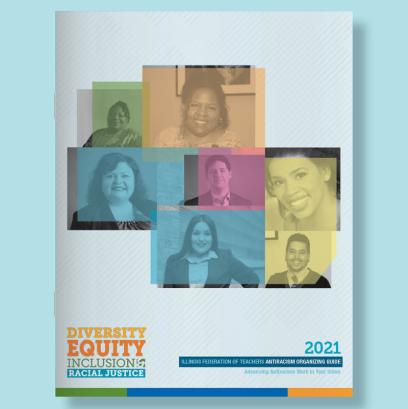Fostering educational justice coalitions, with parents and community organizations deeply embedded in Black, Latine, and Indigenous communities, has been central to the Chicago Teachers Union’s success, so I was highly motivated to help the Illinois Federation of Teachers (IFT) develop its 2021 Antiracism Organizing Guide (available for free at go.aft.org/ixj). Occasionally, union members who are new to coalition building will ask why we have to focus on antiracism. While the civics teacher in me prefers to challenge white supremacy and our roots as a settler colonist society—from stealing Indigenous lands to enslaving people to redlining—the IFT’s guide is easy to use and direct. As it explains:
[Antiracist work] is imperative to us winning. Race baiting has always been used as a strategy to divide workers and push anti-labor, corporate interests. Racial solidarity is our strategy to build power and dismantle oppressive systems that exploit working people.1
I hope everyone will embrace antiracist work in order to, as the guide says, “create a world where we can all live fully in our humanity.”2 The union movement was built upon the need for “Black and white to unite and fight,”3 and it can only grow through a similar approach.
Along with offering examples of how several IFT locals—including the Chicago Teachers Union and Granite City Federation of Teachers—are advancing antiracism, the guide shares several ways to bring antiracism into standard union processes and practices. The excerpts below (from page 5 of the guide) show some of the ways that all teachers unions could engage in this work.
Antiracist work starts with examining the many systems, policies, and practices of a workplace and union. Are they producing racist outcomes? Do they center the needs of the most marginalized, excluded, and exploited?
- Recruitment, hiring, retention, and promotion
What processes are used to recruit and hire candidates? Is the candidate pool diverse? Are there internal systems to ensure that there is intentional outreach to historically marginalized groups? Are there support systems in place for diverse candidates to succeed and thrive in your workplace? Are BIPOC [Black, Indigenous, and people of color] members disproportionately assigned to less desirable work that is compensated at a lower rate?
- Union leadership
Does the leadership of your local/council/chapter reflect the diversity of your membership? The community you serve? Are there opportunities for engagement and participation for all members? Are the contributions and participation of all members welcomed and valued? How does the local/council/chapter encourage or discourage the engagement and participation of underrepresented groups?
- Curricula
Do students see themselves in positive and affirming ways within the curricula? Do they have an opportunity to “see” and learn about other cultures and their contributions to society? Do the curricula encourage students to critique and challenge systems? Does it encourage students to ask questions or just answer questions?
- Discipline policies and procedures
- Students: Are Black students, students with disabilities, or queer students disciplined more frequently or more harshly than their peers? Do students have more access to police than to social workers, counselors, or psychologists? What about dress codes: Does the district discourage certain hairstyles and styles of dress that are commonly associated with non-white cultures?
- Members: Are folks of color or LGBTQIA+ folks disciplined more frequently/harshly? Does the code of “professional dress” adhere to white standards? Do certain rules impact marginalized staff more than others? Are rules fairly applied?
- Class/student assignments
Are Black and brown teachers more often assigned “those kids”? Do Black and brown teachers have less access to teaching higher-level courses (i.e., Advanced Placement and honors)? Are Black and brown students underrepresented in Advanced Placement and honors courses and overrepresented in remedial courses? How is student placement in these courses determined?
Teachers unions that engage and act upon these ideas—as well as the others that are offered in the IFT’s guide—will be well prepared to help build the broad, diverse, and anti-racist coalitions that are necessary to meet our students’ needs.
Endnotes
1. Illinois Federation of Teachers, Antiracism Organizing Guide: Advancing Antiracism Work in Your Union (Westmont, IL: 2021), c762f3cd-45f3-45ff-afbc-9ed8df287a9b.usrfiles.com/ugd/c762f3_b513850f02534c4dae4c943018b61344.pdf, 3.
2. Illinois Federation of Teachers, Antiracism Organizing Guide, 3.
3. C. James, “CLR James and the 21st Century,” CLR James Journal 8, no. 1 (Winter 2000/2001): 126–33, jstor.org/stable/26759389.
[updated May 2024]

